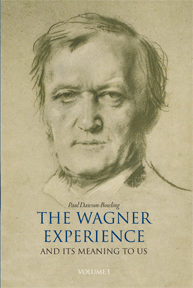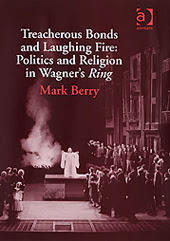“Though this be madness, yet there is method in’t.” A counterfactual analysis of Richard Wagner’s Tannhäuser.

Chrissochoidis, I.; Harmgart, H.; Huck, S.; Müller, W.; (2010) “Though this be madness, yet there is method in’t.” A counterfactual analysis of Richard Wagner’s Tannhäuser. (ELSE Working Papers 377). ESRC Centre for Economic Learning and Social Evolution: London, UK.
Much like Wagner himself, the eponymous hero of Tannhäuser treads a path of stark contrasts and
rapid swings. From Wartburg to the Venusberg and to the Vatican, the gifted bard transforms from
self-centered artist to seduced disciple, disillusioned devotee, hopeful lover, self-loathing pilgrim and
finally redeemed martyr. He tries everything and everything is trying. These contrasts reach a peak in
the opera‟s central episode, the song contest at Wartburg. Tannhäuser has just been welcomed at the
court, received Elisabeth‟s favor and affection, and is ready to compete for the contest‟s prize, one as
lofty as possibly the princess‟ hand. Instead of securing his reintegration to Wartburg with a brilliant
performance, however, he spoils the event with insolent remarks and the exhibitionist disclosure of
his Venusberg experience. His behavior offends his peers, scandalizes the court, breaks Elisabeth‟s
heart, and brings him to the edge of death. Why would Tannhäuser sacrifice everything for nothing?
LANDGRAF
... Have you returned to the circle
you forsook in haughty arrogance?
WOLFRAM
... when, in haughtiness, you left us,
In the Venusberg, we find him incapable of fulfilling his duties (all attempts to praise the goddess end
up in complaints and self-pity) and his betrayal of Venus with the Virgin Mary (“mein Heil ruht in
Maria!” [my salvation rests in Mary!] Act 1, sc. 2, l. 302) is followed by swapping the latter for
Princess Elisabeth and then her, too, for a limelight moment of swaggering self-adulation. This, in
turn, he publicly regrets preferring penance over sin, a penchant he is no longer sure of when he finally returns to Wartburg. Thus, Tannhauser‟s irrational behavior in the song contest is not
surprising; indeed, it prepares us for the opera‟s tragic end. A man of such swings of mood and action will never find peace in this world.
Another explanation points the finger to Wagner himself, who forged a story out of two loosely
connected tales, recorded in the opera‟s title (Tannhäuser und der Sängerkrieg auf Wartburg). The
need for formal discipline (for example, having the big climax just before the end of Act 2) overrode
that for dramatic conviction. Whether for structural or philosophical reasons, Wartburg had to appear
midway between the Venusberg and Rome, the song contest should stand between a life of sin and
one of redemption, and Elisabeth had to become “the woman who, star-like,” leads Tannhäuser “from
the hot passion of the Venusberg to Heaven”.
Both explanations are valid and offer insights into Tannhäuser‟s reckless behaviour. Like most
exegetical efforts on the opera, however, they take for granted the hero‟s hyper-emotional nature,
compulsiveness, and spontaneity.3 Issues of choice, planning and strategy, are left out of the picture, as if his actions are involuntary responses to external stimuli and his decisions lack any kind of mental
processing. Yet his departure from the Venusberg is a conscious choice arrived at through rational
thinking. Memories of his past life interlace and clash with his present Venusian experiences, leading
to comparison and, ultimately, preference for the one over the other. His longing for change and
freedom in Act 1 shows an active mind capable of choosing between alternatives. This is indeed the
subject of his lengthy argument with Venus (reminiscent of the Orpheus-Euridice confrontation in
Gluck‟s Orfeo). Tannhäuser abandons the Venusberg fully aware of the privileges he leaves behind
and the hardships lying ahead:
TANNHÄUSER
for freedom, then, I long,
for freedom, freedom, do I thirst;
for struggle and strife I will stand,
though it be, too, for destruction and death:
from your kingdom, therefore, I must fly,
(Act 1, sc. 2, ll. 209-13)
Similarly, in his encounter with the knights, we find him resisting their offer, which shows at least
knowledge of two alternative paths. He agrees to join them only when Wolfram reveals Elisabeth‟s
favorable response to his songs. In what statisticians call Bayesian updating,4 Tannhäuser revises his
beliefs about Wartburg and his decision not to look back (“denn rückwärts darf ich niemals seh‟n.”
Act 1, sc. 4, l. 424). Learning about Elisabeth‟s feelings makes a return to Wartburg into a compelling choice (“Ha, jetzt erkenne ich sie wieder, / die schöne Welt, der ich entrückt!” [Ha, now I recognize it again, the lovely world that I renounced!] Act 1, sc. 4, ll. 474-75).
Pursuing this line of inquiry, this paper offers a new reading of the Sängerkrieg auf Wartburg. We
propose that Tannhäuser‟s seemingly irrational behaviour is actually consistent with a strategy of
redemption, in ways that recall Polonius‟s famous diagnosis of Hamlet “Though this be madness, yet
there is method in‟t.”5 We also suggest that he consciously disrupts the contest, knowing that only a
public disclosure of his sinful past can propel him on the path of redemption.
 Wagner reached a point in his struggling years when he felt pulled in too many directions. His letters to several friends describe the torment of multiple, diverse musical themes pulling his creativity in diverse directions. He decided to halt the composition of Siegfried almost in the middle of the Second Act to allow the growing theme
Wagner reached a point in his struggling years when he felt pulled in too many directions. His letters to several friends describe the torment of multiple, diverse musical themes pulling his creativity in diverse directions. He decided to halt the composition of Siegfried almost in the middle of the Second Act to allow the growing theme 






.jpg)












































